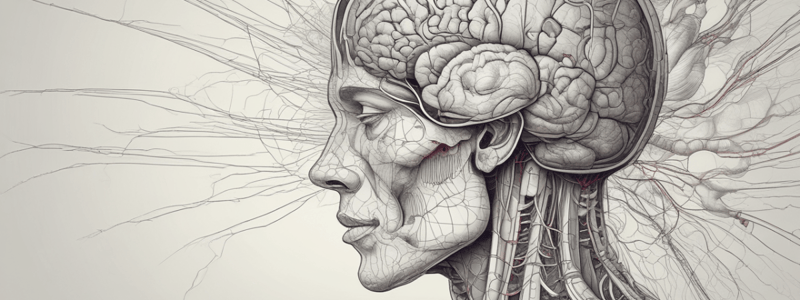Podcast
Questions and Answers
What percentage of the brain is composed of cerebral spinal fluid?
What percentage of the brain is composed of cerebral spinal fluid?
- 20%
- 10% (correct)
- 30%
- 40%
Which part of the brain is responsible for processing visual information?
Which part of the brain is responsible for processing visual information?
- Temporal lobe
- Parietal lobe
- Frontal lobe
- Occipital lobe (correct)
What is the function of the cerebellum?
What is the function of the cerebellum?
- Responsible for speech center
- Processes auditory information
- Controls voluntary motor action
- Coordinates body movements (correct)
What is the main difference between a head injury and a traumatic brain injury (TBI)?
What is the main difference between a head injury and a traumatic brain injury (TBI)?
What is the function of the spinal cord?
What is the function of the spinal cord?
What is the name of the opening through which the brain connects to the spinal cord?
What is the name of the opening through which the brain connects to the spinal cord?
What are the four major bones that make up the cranium?
What are the four major bones that make up the cranium?
What are the three layers of protection for the central nervous system?
What are the three layers of protection for the central nervous system?
Flashcards are hidden until you start studying
Study Notes
Nervous System Basics
- The nervous system is a complex network of nerve cells that enables all parts of our body to function.
- It includes the brain, spinal cord, and peripheral nervous system (PNS).
Head Trauma and Injuries
- Head trauma refers to both head injuries and traumatic brain injuries (TBI).
- A head injury is a traumatic injury to the head that may result in injury to the scalp, head, or skull, but not including the face.
- TBI is an injury to the brain caused by an external force.
Central Nervous System (CNS)
- The CNS is composed of the brain and spinal cord.
- It controls voluntary activities (actions we consciously perform) and involuntary actions (actions not under our conscious control).
- The CNS is divided into the brain and spinal cord, which are protected by the meninges (three layers: dura mater, arachnoid, and pia mater).
Brain Structure and Functions
- The brain connects to the spinal cord through the foramen magnum.
- The brain is composed of 80% brain tissue, 10% blood supply, and 10% cerebral spinal fluid (CSF).
- The four major bones that make up the cranium are the occipital, temporal, parietal, and frontal regions.
- The brain is our center of consciousness, responsible for higher functions, and is divided into left and right hemispheres.
- The cerebrum is responsible for higher functions, and is divided into lobes:
- Frontal lobe: voluntary motor action and personality traits
- Parietal lobe: motor functions for the opposite side of the body, memory, and emotions
- Occipital lobe: processing visual information
- Temporal lobe: speech center, long-term memory, hearing, taste, and smell
- The cerebellum coordinates body movements, and the brain stem controls virtually all life functions.
Spinal Cord and Peripheral Nervous System (PNS)
- The spinal cord transmits nerve impulses between the brain and the rest of the body.
- The PNS conducts sensory and motor impulses to and from the skin, muscles, and other organs to the spinal cord.
- The PNS has 31 pairs of spinal nerves and 12 pairs of cranial nerves.
- The peripheral nerves conduct sensory impulses from skin and other organs to the spinal cord, and motor nerves carry information from the CNS to the muscles.
Autonomic Nervous System
- The autonomic nervous system is controlled by the hypothalamus.
- It has two divisions:
- Sympathetic nervous system: "fight or flight" response, controlled by the hypothalamus, may disrupt the flow of sympathetic communication above T6.
- Parasympathetic nervous system: conserves energy and maintains organ function, disruption of which results in loss of bladder and bowel tone, and sexual function.
Nervous System Basics
- The nervous system is a complex network of nerve cells that enables all parts of our body to function
- It consists of the brain, spinal cord, and peripheral nervous system (PNS)
Head Trauma and Injuries
- Head trauma refers to both head injuries and traumatic brain injuries (TBI)
- A head injury is a traumatic injury to the head that may result in injury to the scalp, head, or skull, excluding the face
- TBI is an injury to the brain caused by an external force
Central Nervous System (CNS)
- The CNS is composed of the brain and spinal cord
- It controls voluntary activities (actions we consciously perform) and involuntary actions (actions not under our conscious control)
- The CNS is protected by the meninges, which have three layers: dura mater, arachnoid, and pia mater
Brain Structure and Functions
- The brain connects to the spinal cord through the foramen magnum
- The brain is composed of 80% brain tissue, 10% blood supply, and 10% cerebral spinal fluid (CSF)
- The four major bones that make up the cranium are the occipital, temporal, parietal, and frontal regions
- The brain is our center of consciousness, responsible for higher functions, and is divided into left and right hemispheres
- The cerebrum is responsible for higher functions and is divided into lobes:
- Frontal lobe: voluntary motor action and personality traits
- Parietal lobe: motor functions for the opposite side of the body, memory, and emotions
- Occipital lobe: processing visual information
- Temporal lobe: speech center, long-term memory, hearing, taste, and smell
- The cerebellum coordinates body movements
- The brain stem controls virtually all life functions
Spinal Cord and Peripheral Nervous System (PNS)
- The spinal cord transmits nerve impulses between the brain and the rest of the body
- The PNS conducts sensory and motor impulses to and from the skin, muscles, and other organs to the spinal cord
- The PNS has 31 pairs of spinal nerves and 12 pairs of cranial nerves
- Peripheral nerves conduct sensory impulses from skin and other organs to the spinal cord
- Motor nerves carry information from the CNS to the muscles
Autonomic Nervous System
- The autonomic nervous system is controlled by the hypothalamus
- It has two divisions:
- Sympathetic nervous system: "fight or flight" response, controlled by the hypothalamus, may disrupt the flow of sympathetic communication above T6
- Parasympathetic nervous system: conserves energy and maintains organ function, disruption of which results in loss of bladder and bowel tone, and sexual function
Studying That Suits You
Use AI to generate personalized quizzes and flashcards to suit your learning preferences.




